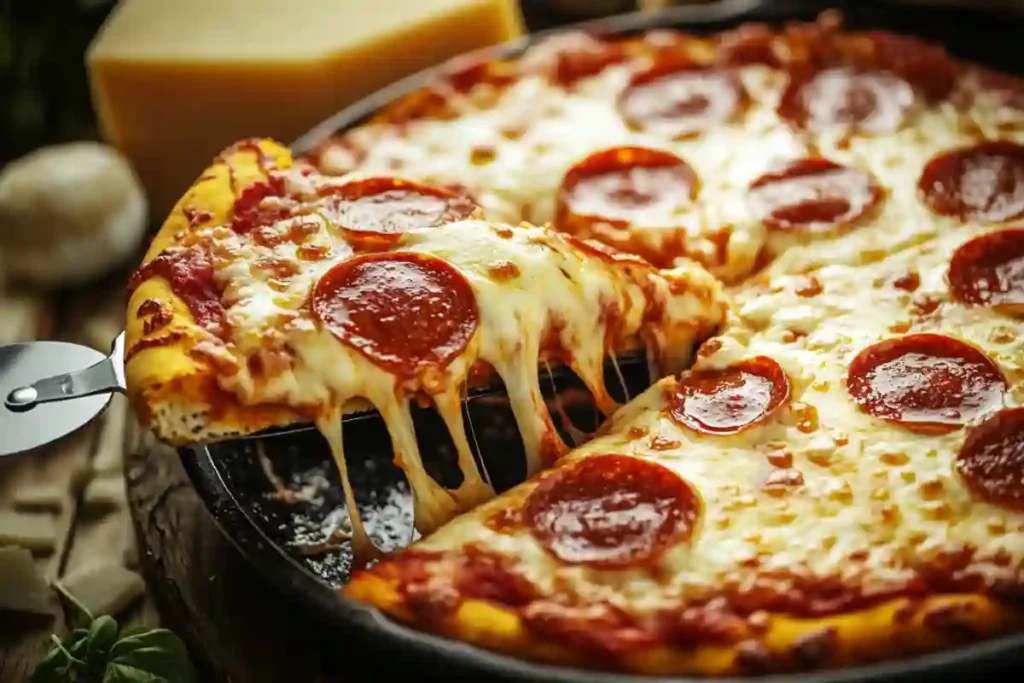If you love homemade pizza, you know how essential the right tools are for achieving that perfect crust. Two popular options for pizza enthusiasts are the pizza stone and the cast iron pizza pan. But which is better? Let’s break down the differences, benefits, and drawbacks of each to help you make an informed decision.
Introduction : Which is better pizza stone or cast iron pizza pan?
When it comes to making pizza at home, the right cooking surface can make all the difference. Pizza stones and cast iron pizza pans are designed to help you achieve that crispy crust and evenly cooked toppings, but they differ in materials, usage, and results. In this guide, we’ll explore each option in-depth, so you can decide which tool best fits your needs. Whether you are aiming for thin and crispy or thick and chewy, understanding these tools will help elevate your homemade pizza experience. By the end of this comprehensive comparison, you’ll have all the information you need to make an informed decision.

What Is a Pizza Stone?
A pizza stone is a flat, heavy slab made from ceramic, stone, or cordierite. It’s designed to mimic the surface of a traditional pizza oven, retaining and evenly distributing heat for a crispy crust. It is widely regarded as an essential tool for those looking to replicate a pizzeria-quality pizza in their home oven. The porous surface is key to its effectiveness, absorbing moisture from the dough and ensuring a perfectly crisp finish. For those prioritizing texture and taste, a pizza stone can be an excellent investment.
Key Features of a Pizza Stone:
- Material: Typically made of ceramic, stone, or cordierite.
- Heat Retention: Maintains high, even heat.
- Cooking Style: Ideal for thin-crust pizzas.
- Weight: Generally lighter than cast iron pans.
Benefits of Using a Pizza Stone
A pizza stone creates the ideal crispy, brick-oven-like crust that many pizza enthusiasts desire. Its material retains heat exceptionally well, ensuring even cooking throughout the crust. Lightweight compared to cast iron pans, it’s easier to maneuver in and out of the oven. Beyond pizza, it’s versatile enough to bake bread, cookies, or even reheat leftover pizza to perfection. The porous surface absorbs excess moisture from the dough, contributing to the signature crispiness. Additionally, the heat distribution of the stone ensures that the toppings cook evenly, avoiding sogginess in the center while still achieving a perfectly browned crust on the outside.
Drawbacks of Pizza Stones
Despite their advantages, pizza stones have limitations. They’re prone to cracking, especially if exposed to rapid temperature changes, such as placing a cold stone in a hot oven. Maintenance can be tricky since they’re prone to stains and must be cleaned without soap to avoid lingering tastes. Preheating a pizza stone also takes time, typically 30 to 45 minutes, which might be inconvenient for those seeking quicker cooking options. Furthermore, they require careful handling during cleaning and storage, as their brittle nature makes them more vulnerable to accidental damage.
What Is a Cast Iron Pizza Pan?
A cast iron pizza pan is a thick, durable pan made of cast iron. Known for its versatility, it can be used on the stovetop, grill, or oven. It offers a robust and long-lasting solution for pizza enthusiasts who prefer a thicker crust. With its superior heat retention, a cast iron pan can provide a beautifully golden-brown crust that holds up well under a variety of toppings. Whether you’re making a classic Margherita or a loaded meat lovers’ pizza, cast iron ensures consistent cooking results.
Key Features of a Cast Iron Pizza Pan:
- Material: Solid cast iron.
- Heat Distribution: Excellent heat retention and even cooking.
- Cooking Style: Great for deep-dish or pan-style pizzas.
- Weight: Heavier than pizza stones.
Benefits of Using a Cast Iron Pizza Pan
Cast iron pizza pans stand out for their durability and exceptional heat retention. Unlike pizza stones, they heat up faster, usually in 10-15 minutes, saving time. A well-seasoned pan creates a natural non-stick surface, making it easier to remove pizzas without sticking. Their versatility allows for use not just in ovens but also on stovetops or grills, opening up a variety of cooking possibilities. They’re ideal for achieving a golden-brown crust, particularly for deep-dish or pan-style pizzas. Furthermore, the ability to use them for other cooking tasks, like roasting vegetables or frying meats, adds significant value for multitasking in the kitchen.
Drawbacks of Cast Iron Pizza Pans
On the downside, cast iron pizza pans are heavier and more cumbersome to handle. Proper maintenance is essential to prevent rust, which involves regular seasoning. Cleaning a cast iron pan can also be more involved, as abrasive scrubbing can damage the seasoning. Although durable, they might not offer the same brick-oven authenticity that a pizza stone can deliver. Additionally, some users might find the seasoning process tedious or challenging, especially if they’re unfamiliar with cast iron cookware.
Comparing Pizza Stones and Cast Iron Pizza Pans
1. Cooking Performance
- Pizza Stone: Perfect for achieving a crisp, light crust due to its porous surface.
- Cast Iron Pizza Pan: Excels at creating a thicker, chewy crust with even browning.
Both tools deliver exceptional results but cater to different pizza styles. Pizza stones excel in replicating the thin, crispy crusts characteristic of Neapolitan-style pizzas. In contrast, cast iron pans shine when preparing thicker, heartier crusts, such as those found in Chicago-style deep-dish pizzas. The choice between the two depends largely on personal preference and the type of pizza you enjoy making most often.
2. Preheating Time
- Pizza Stone: Requires longer preheating (usually 30-45 minutes).
- Cast Iron Pan: Heats up in about 10-15 minutes.
The significant difference in preheating time can influence your choice. A pizza stone’s longer preheating ensures consistent heat distribution but requires advanced planning. Cast iron pans, with their quicker heat-up time, are more convenient for spontaneous pizza nights. However, if you’re willing to wait, the pizza stone’s benefits in crust texture might outweigh the inconvenience of its preheating requirements.
3. Versatility
- Pizza Stone: Primarily used for baking pizzas and bread.
- Cast Iron Pan: Can handle pizzas, frying, roasting, and more.
Cast iron pans are undeniably more versatile. While pizza stones focus on baking, cast iron pans double as cookware for frying vegetables, searing steaks, or even roasting chicken. This multifunctionality can be a game-changer for those with limited kitchen space or who prefer tools that offer multiple uses. A cast iron pan’s versatility is especially appealing to those who enjoy experimenting with recipes beyond traditional pizza.
4. Durability
- Pizza Stone: Fragile and can crack if dropped or exposed to sudden temperature changes.
- Cast Iron Pan: Highly durable and can last for decades with proper care.
Durability is a significant factor. A pizza stone’s fragility makes it less suitable for frequent handling, while a cast iron pan’s resilience ensures it can withstand rough usage, making it a long-term investment. If durability is a primary concern, a cast iron pan is a clear winner, especially in households where kitchen tools often endure heavy use.
5. Ease of Cleaning
- Pizza Stone: Cannot be washed with soap; cleaning requires scraping and light water use.
- Cast Iron Pan: Easier to clean but needs regular seasoning.
Cleaning methods differ significantly. Pizza stones require delicate scraping to preserve their porous surface, while cast iron pans—though easier to clean—demand periodic seasoning to maintain their quality. Understanding the cleaning process for each option is essential to ensure longevity and performance. A pizza stone’s unique cleaning requirements might not suit everyone, particularly those who prefer straightforward cleaning solutions.
Additional Sections and Insights
6. Heat Distribution Comparison
Both pizza stones and cast iron pans excel in heat distribution, but the way they handle it differs. Pizza stones slowly absorb and radiate heat evenly, ensuring the dough cooks uniformly and creating that perfect crispness. Conversely, cast iron pans retain heat intensely, providing immediate and powerful heat transfer to the crust. While the cast iron’s efficiency works wonders for thicker crusts, the pizza stone’s gradual heating suits traditional thin-crust pizzas.
7. Portability and Storage
Portability is an important consideration. Pizza stones are lighter but fragile, requiring careful handling. Cast iron pans are heavier but can endure rough use, making them better for outdoor cooking. In terms of storage, cast iron pans are compact and stackable, while pizza stones often require a flat, protected space to avoid damage.
8. Price and Availability
Generally, pizza stones are more affordable, with a wide range of options available in kitchen stores or online. Cast iron pans, while slightly more expensive, offer greater versatility and durability. Long-term cost-effectiveness leans toward cast iron pans due to their resilience and multifunctionality.
9. Environmental Impact
From an eco-friendly perspective, cast iron pans are highly sustainable due to their durability and reusability. Pizza stones, while effective, often need replacement after significant wear or accidental damage. Cast iron’s ability to last for generations makes it the greener choice.
10. Aesthetics and Presentation
Pizza stones add an authentic, artisanal feel when serving pizza straight from the oven. Cast iron pans, on the other hand, offer a rustic, hearty presentation, especially for deep-dish pizzas. Both options have their charm, but the choice depends on the occasion and personal aesthetic preferences.
Frequently Asked Questions
- Can I use a pizza stone on a grill?
Yes, you can use a pizza stone on a grill, but it’s important to handle it carefully to avoid damage. To prevent the stone from cracking, avoid sudden temperature changes. Gradually heat the pizza stone along with the grill to allow it to adjust to the temperature evenly. This method helps achieve great results when grilling pizzas outdoors. - Do cast iron pizza pans require seasoning?
Absolutely, cast iron pizza pans require seasoning to maintain their non-stick properties and prevent rust. Seasoning involves applying a thin layer of oil, such as vegetable or flaxseed oil, and then heating the pan either in the oven or on a stovetop. Regular seasoning keeps the pan in excellent condition and enhances its longevity. - Which is better for thin crust pizza?
For thin crust pizza, pizza stones are often preferred. The porous surface of a pizza stone absorbs excess moisture from the dough, creating a crispier crust that is characteristic of thin-crust pizzas. If you love the authentic, slightly charred texture of pizzeria-style thin crusts, a pizza stone is your best bet. - Are cast iron pizza pans oven-safe?
Yes, cast iron pizza pans are oven-safe and incredibly versatile. They can also be used on stovetops and grills, making them suitable for a variety of cooking methods. Their ability to retain heat evenly ensures consistent cooking, whether you’re baking a pizza or grilling vegetables. - Can I use parchment paper with both tools?
Yes, parchment paper is a useful accessory for both pizza stones and cast iron pizza pans. It prevents sticking and makes cleanup easier. However, always check that the parchment paper is rated for the high temperatures you’ll be cooking at to avoid burning or degrading during the cooking process.
Conclusion : Which is better pizza stone or cast iron pizza pan?
When deciding between a pizza stone and a cast iron pizza pan, consider your preferences and cooking style:
- Pizza Stone: Ideal for those who love traditional, crispy crusts and enjoy the ritual of pizza-making. A pizza stone mimics the conditions of a brick oven, making it perfect for artisanal pizzas.
- Cast Iron Pizza Pan: A versatile option for those who prioritize durability and convenience. Cast iron pans are easy to handle and can be used across different cooking methods, from baking to grilling.
Both tools bring unique benefits to your homemade pizza-making process. Choose the one that aligns with your needs, and you’ll enjoy delicious, restaurant-quality pizzas in the comfort of your home.
Related article : Pizza Pan: How to Choose the Best One

